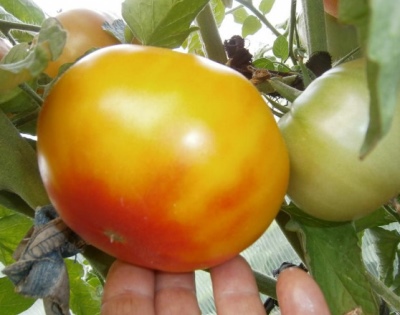
- Name synonyms: Grapefruit
- Category: grade
- Growth type: indeterminate
- Appointment: fresh consumption, for ketchup and tomato paste
- Ripening period: mid-season
- Ripening time, days: 110-115
- Growing conditions: for greenhouses
- Bush size: tall
- Bush height, cm: 200-250
- Bush characteristic: powerful
There are many varieties of tomatoes, and their number only increases every year. Among them, bicolors are especially distinguished - two-color fruits that have gained immense popularity due to their beauty and originality. At the same time, they also differ in higher taste when compared with other tomatoes, including monochromatic ones. Accordingly, such specimens receive higher marks from professional tasters.
It is to this group of varieties that one of these bicolors belongs - the Grapefruit tomato. Beautiful yellow-raspberry fruits are also large in size. The variety is called so because it closely resembles the famous fruit in its shape and color. Moreover, when cut, it also looks like a citrus fruit.
Description of the variety
Tomato Grapefruit is considered an indeterminate plant. This is a non-standard bush, reaching a height of 2 to 2.5 meters. Accordingly, he needs a pinching and a garter. The first brush is usually formed over 8 or 9 leaves. The leaves are like potato tops. The variety is distinguished by a fairly high resistance to diseases.
The main qualities of the fruit
Grapefruit Tomatoes are quite large. They have a flat-round shape. The color is yellow when mature, with a raspberry blush. The mass of each fruit is quite large - from 300 to 500 grams, and individual large specimens with good care can reach a kilogram or even more - 1.2 kg. The cut flesh is very beautiful - it is yellow and has pink stripes. Dry substances are contained in large quantities, seeds are small in number, and there are no chambers at all.
Taste characteristics
Tomato has a rather sweet taste, which can be called rich and even exotic, so vegetables are most often consumed fresh - for salads and vegetable cuts. The fruits are practically not used for the production of tomato juice and for harvesting for the winter, as they have a huge size, inconvenient for canning. The only exception is making a sauce from them, and also delicious ketchup and tomato paste are obtained.
Ripening and fruiting
The grapefruit variety belongs to mid-season crops: in order for the fruits to ripen, it takes from 110 to 115 days. The crop can be harvested from July to September.
Yield
As for the yield of grapefruit tomatoes, it is quite high: from one square meter you can collect from 9 to 10 kilograms of beautiful and tasty fruits.
The timing of planting seedlings and planting in the ground
The cultivation of a tomato of the variety in question is traditionally through seedlings. Moreover, in order to get it, it is necessary to sow seeds in the first days of March, namely from the 1st to the 15th. It will be possible to plant seedlings in open ground starting from May 15, the deadline is June 5.
In this case, planting tomato seedlings in open ground should be carried out after the probability of frost return is reduced to zero. In a closed greenhouse, the culture is planted a week or two earlier.

Growing tomato seedlings is an extremely important process, because it largely depends on whether the gardener can harvest at all. All aspects must be taken into account, from seedbed preparation to planting in the ground.
Landing scheme
To plant a tomato Grapefruit should be according to the scheme 60x50 cm. So the plants will be more comfortable.

Growing and care
Experts recommend growing grapefruit tomato in closed greenhouses or in a greenhouse. True, many gardeners get good harvests in the open field. A couple of weeks before planting seedlings, the soil should be treated with Fitosporin.
A distance of 50 cm is maintained between the bushes, and the row spacing is 40 cm. The holes should be prepared in advance, the seedlings in them should be placed in the direction from north to south, and then covered with earth. After that, be sure to water. However, as the Grapefruit grows later, it does not need to be watered too often. If the weather is not very hot, it will be enough once every 7 days.
The variety responds well to feeding. During the season, you should definitely feed the culture 3 times - as a rule, mullein and mineral compositions are used. Foliar feeding with solutions of iodine, manganese, boric acid, as well as such compositions as "Epin", "Zircon", "HB-101" will be useful for the good development of the plant. Processing should be done regularly every 10 days.
If the weather and climate in your area allows, the tomato variety Grapefruit is still best grown outdoors. In this case, the main thing is to choose the right place of growth. First of all, it should be a sunny and well-lit area, without any stagnation of water. When it comes to crop rotation, the best precursors for tomatoes are radishes, carrots, beets, cabbage, legumes, and lettuce.




A plant needs different micronutrients at each stage of growth. All fertilizers can be divided into two groups: mineral and organic. Folk remedies are often used: iodine, yeast, bird droppings, eggshells.
It is important to observe the rate and period of feeding. This also applies to folk remedies and organic fertilizers.


Review overview
Grapefruit tomatoes are very fond of many amateur gardeners. In their reviews, gardeners praise the fruits for an unusual beautiful two-tone color scheme, large sizes, and the sugary taste of the pulp. In addition, the harvest is well kept.
They also note the ease of care - a garter and the formation of a bush are enough. True, due to the fact that the ripening period of fruits in the middle lane is extended, most often the Grapefruit tomato is grown in a greenhouse.

























































































